HP EliteBook 8740w: IPS on the Go
by Dustin Sklavos on December 8, 2010 3:10 AM EST- Posted in
- Laptops
- IT Computing
- Intel
- HP
- EliteBook
- Mobile Workstation
- Quadro
- NVIDIA
Futuremark and Gaming
Since NVIDIA's Quadro 5000M is the fastest mobile workstation GPU they offer, we figured it would be only fair to put it through its paces in our "High" and "Ultra" presets. Again it's going to face off against some of the desktop systems we've tested to give you some idea of the performance difference, but it's also important to remember that this chip is tuned for OpenGL and workstation-class workloads, not gaming.
We'll start with Futuremark, just to get it out of the way.
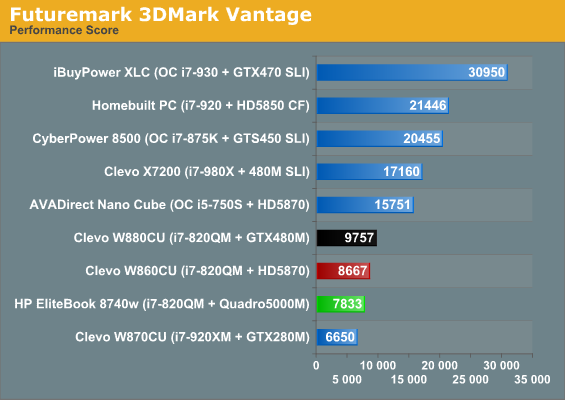
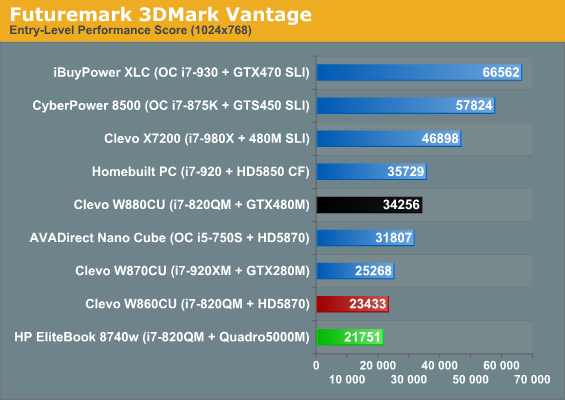
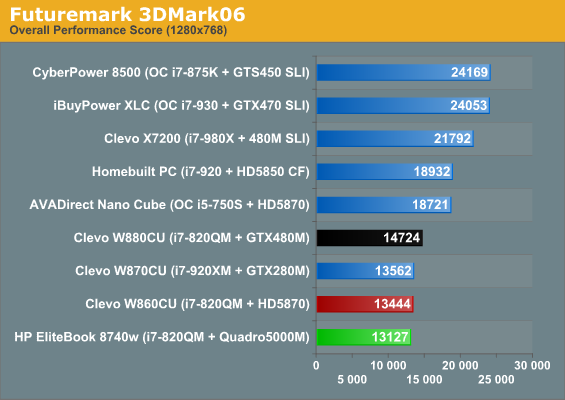
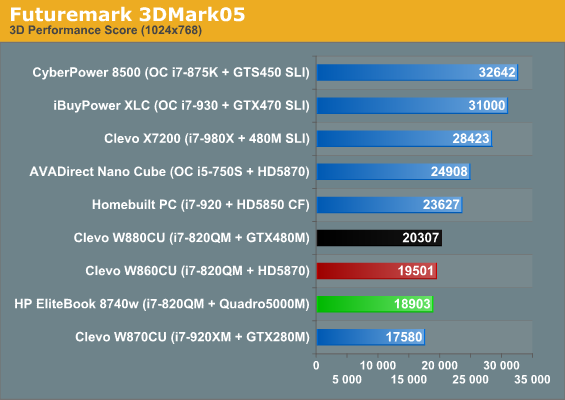
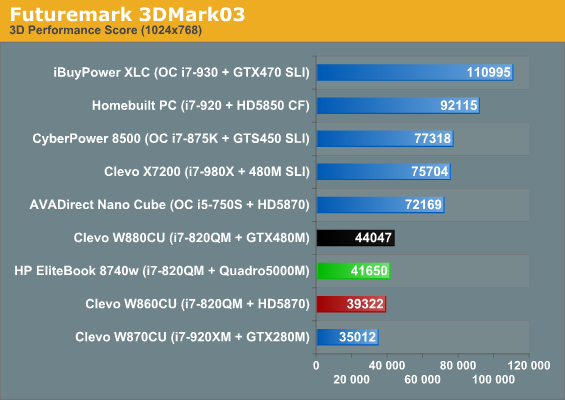
Futuremark performance isn't too impressive, with the GTX 480M posting a comfortable lead over its OpenGL-optimized sibling. Let's see what happens when we move to gaming in our "High" preset, though.
At this point it's worth mentioning that though the EliteBook's screen runs at a (very attractive) 1920x1200 native resolution, we've stuck with our 16:9 benchmark resolutions. The performance difference between 1080p and 1920x1200 is slight, and doing so helps us keep results consistent with the other notebooks we test.
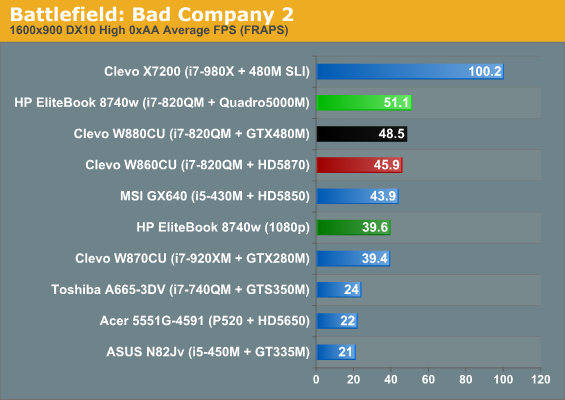
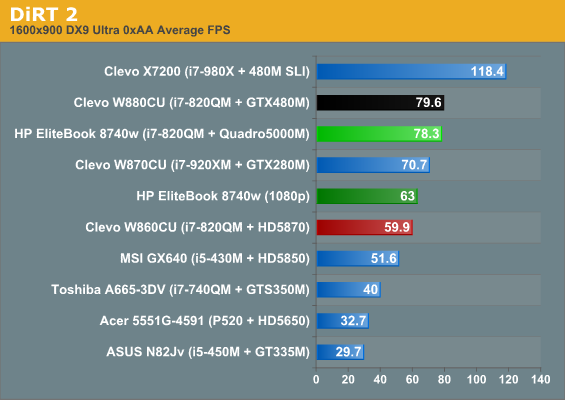
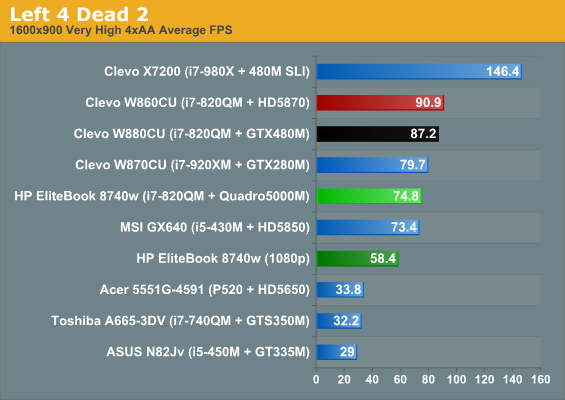
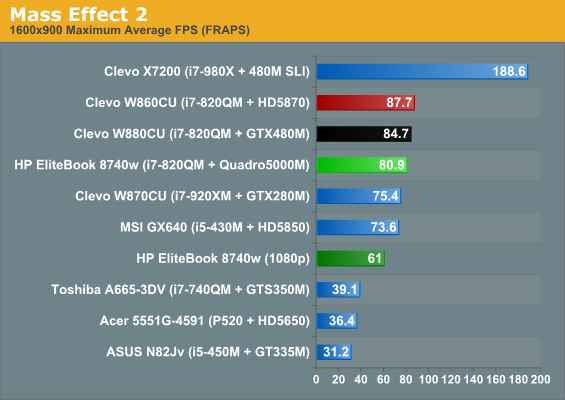
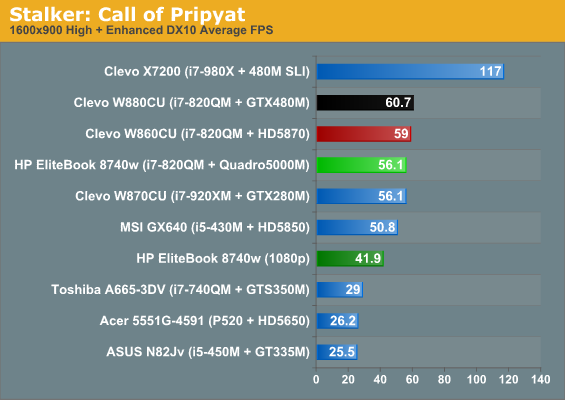
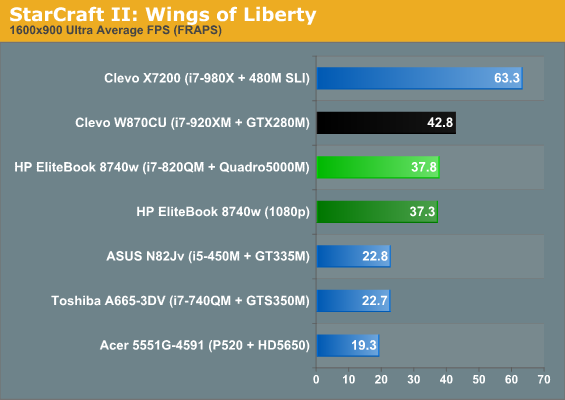
First, the great news: even at our "High" preset the 5000M in the EliteBook is able to post consistently playable numbers at 1080p with more than enough room to breathe. It trades blows with both the GeForce GTX 480M and ATI's Mobility Radeon HD 5870—not too shabby. But let's see what happens when we really max things out.
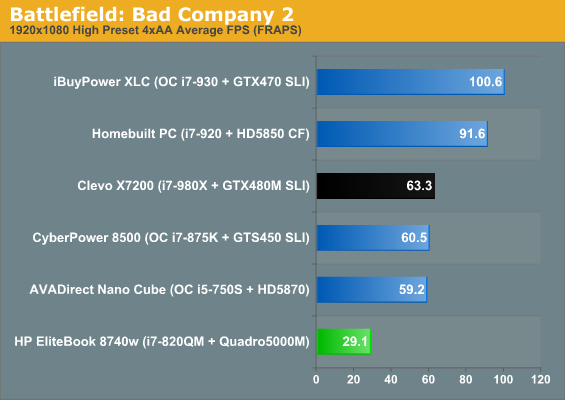


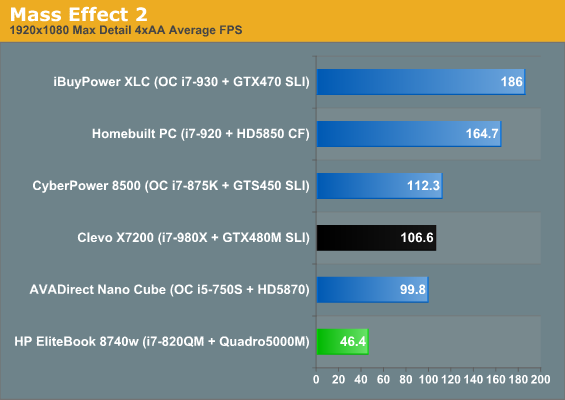
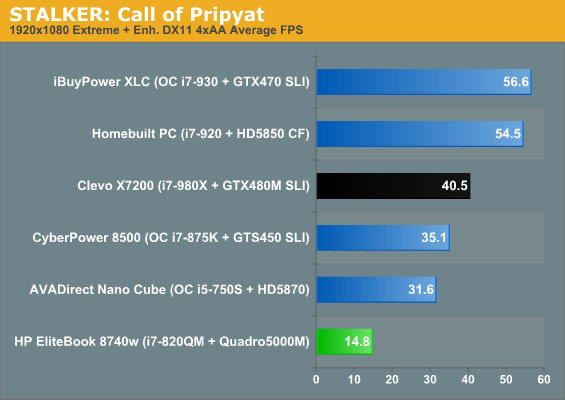
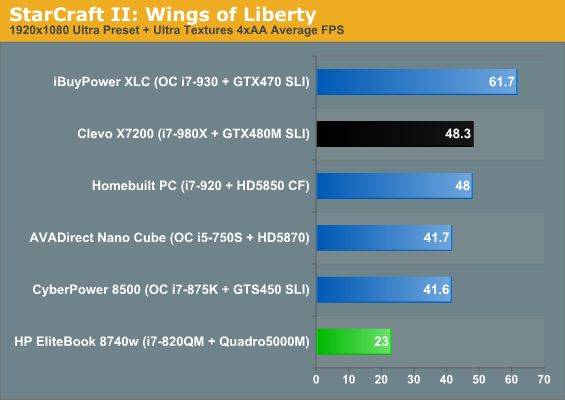
Unfortunately it's at these ultra settings that the 5000M really starts to struggle, and it's here we see the massive gulf in performance between desktop and mobile graphics. While the 5000M is still going to be able to game like a champ (when you're not working, naturally), we still can't help but wonder why NVIDIA's engineers aren't using the far more efficient GF104 chip the GeForce GTX 460 is based on for their mobile high end. AMD isn't doing itself any favors either; the Mobility Radeon HD 5870 was an incremental upgrade on last generation's mobile top end, and they now have the more efficient Barts GPU to build a halfway decent mobile graphics part out of.
The 5000M is fast, but just as we said about its consumer counterpart, the GTX 480M, it just doesn't actually make any sense to cram a horribly truncated GF100 into a laptop. Bring on GF104 or GF110 already.










63 Comments
View All Comments
slacr - Wednesday, December 8, 2010 - link
"Of course, being a Quadro it does bring all of the secret sauce that NVIDIA packages with its workstation class cards"What does this secret sauce do these days, the only documents i've found are rather old and talk of anti-aliasing in CAD software. Other "CUDA capable" cards offer GPU-assistance in for example Adobe CS and CAD software is no longer particularly bound by cpu so the only benefit i've seen is the larger video RAM which can be found on normal cards anyway, so what does the price premium actually buy?
JarredWalton - Wednesday, December 8, 2010 - link
I believe it's line anti-aliasing, better OpenGL drivers (with ISV certification for various applications), and some 64-bit FP performance enhancements. To my knowledge, all of this stuff is available in the standard NVIDIA GPUs, but they only enable it on the Quadro drivers.DanNeely - Wednesday, December 8, 2010 - link
FP64 is the big one. ATI's high end GPUs are limited to FP64 performance that's 1/5th of FP32. Nvidia's high end consumer cards only have 1/.8th, while GT100/110 quadro's are 1/2 (the highest possible without throttling FP32). For scientific computing this is enough to justify paying several times as much as a consumer card so nVidia hobbles the GeForces to support sales of Tesla boxes.mczak - Wednesday, December 8, 2010 - link
FP64 is really for tesla though. Maybe workstation cards still have the full performance FP64 enabled, but honestly noone would care. It's pretty much line aa still I think, plus geforce cards also have artificial limitation on (non-tesselated) geometric throughput.carsandcomps - Thursday, December 9, 2010 - link
The secret sauce is overlay planes and 3D wireframe performance. Consumer cards are great for tesselated 3d with texture maps, but most are pretty horrible when there a hundreds of thousands of 3D wireframe edges in a view.You are correct about the drivers being better also. While a crazy "flareout" or glitch from a surface is no big deal in a game, it is a show stopper on a real 3D engineering model. Not that I am a Nvidia fanboy, but their workstation class drivers have always been better in my opinion.
sheltem - Wednesday, December 8, 2010 - link
I'm pretty sure the Quadro 5000M is the same exact card as the 480M. The main difference is the drivers. You can either hack the driver files to trick it into a 480M (or vice versa) or mod the bios.I actually have the Elitebook 8740w, but with an AMD FirePro 7820. I hacked the Catalyst Mobility drivers to work with my FirePro 7820M.
Zan Lynx - Monday, December 13, 2010 - link
You can hack it, but there's more to it than just the drivers.The Quadro and Tesla hardware goes through a much more careful test process.
The gaming hardware will produce calculation errors fairly often.
The Quadro and Tesla hardware: hardly ever.
yakugo - Monday, March 21, 2011 - link
How/what did you do to hack your 7820 drivers so catalyst control center would work? i have a dell m6500 with the m7820 card. Could you email me at mp3moeny@hotmail.comThanks,
-Aaron
mschira - Wednesday, December 8, 2010 - link
Well, I do appreciate a decent screen, and you know what I might even be ready to pay 550$ extra for it, but a 17" laptop?What's the point for that?
They never fit onto anything else but a desk. Even 15" laptops are a pain to carry around.
So why not get a decent all in one PC like an iMac ?
And why, oh why is there no smaller laptop that offers a decent screen?
M.
damianrobertjones - Wednesday, December 8, 2010 - link
Why an iMac instead of the other oem machines?